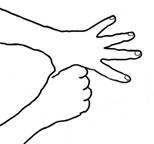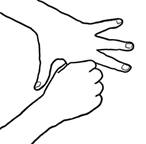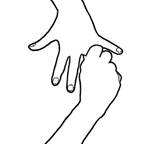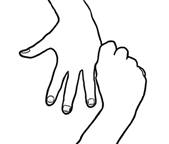In the last post (The Jin Shin Jyutsu practice of holding the fingers) I talked about the two basic ways to practice holding the fingers. You can either hold all ten fingers, one after another, first on one hand and then on the other, or you can concentrate on the attitudes (worry, fear, anger, etc) and the benefits (breathing, digestion, fatigue, etc) associated with just one of the fingers.
I also mentioned that there are two ways to focus on the attitudes and benefits of an individual finger: the “quickie” and the extended sequence. The “quickie” is simply to hold one finger. For example, you can hold the middle finger when you’re feeling angry or the thumb when you’re worried. Jin Shin Jyutsu also provides another way to focus on the benefits of individual fingers: the extended sequence. This simply involves holding two, three, or four fingers one after the other.
Holding the fingers — whether you hold all ten fingers or concentrate on one finger — helps bring balance and harmony to the attitudes underlying physical and emotional conditions. The extended sequence for holding the fingers is a way to support and thus harmonize each of the basic attitudes associated with the individual fingers.
In what follows you’ll find a description of the sequence (for example, hold the thumb, then the middle finger, then the little finger) and a brief explanation of why this particular sequence supports the attitude associated with the finger on which you wish to concentrate.
Remember, the acronym for remembering the attitude associated with each finger is “Get rid of Worry FAST“: Worry / Fear / Anger / Sadness / Trying To.
The extended sequences and why we use these particular fingers
 Worry: The “quickie” is to hold the thumb. The extended sequence is to hold the thumb, then hold the middle finger, then hold the little finger.
Worry: The “quickie” is to hold the thumb. The extended sequence is to hold the thumb, then hold the middle finger, then hold the little finger.
We hold the thumb for Worry. The middle finger (Anger) helps deal with the frustrations that are often associated with Worry. The little finger is associated with the Heart function and helps us take our concerns into the heart, where they can be softened.
 Fear: The “quickie” is to hold the index finger. The extended sequence is to hold the thumb, then the index finger, then the little finger.
Fear: The “quickie” is to hold the index finger. The extended sequence is to hold the thumb, then the index finger, then the little finger.
The thumb is associated with Stomach and Spleen energy, which have to do with digestion and grounding. So holding the thumb when there is Fear helps bring our energy down (grounding) and gives us energy (digestion). We hold the index finger for Fear. Holding the little finger, associated with Heart energy, supports and energizes the process of dealing with Fear.
 Anger: The “quickie” is to hold the middle finger. The extended sequence is to hold the little finger, then the ring finger, then the middle finger.
Anger: The “quickie” is to hold the middle finger. The extended sequence is to hold the little finger, then the ring finger, then the middle finger.
Holding the little finger when we are angry alleviates the heat of anger (the Fire element is associated with the Heart). Holding the ring finger, which is associated with Lung energy, helps us breathe. We hold the middle finger for Anger.
 Sadness/Grief: The “quickie” is to hold the ring finger. The extended sequence is to hold the thumb, then the index finger, then the middle finger, and then the ring finger.
Sadness/Grief: The “quickie” is to hold the ring finger. The extended sequence is to hold the thumb, then the index finger, then the middle finger, and then the ring finger.
Holding the thumb helps us with the Worry that is often involved in Grief. Holding the index finger helps us deal with our fears, which can deplete our reserves. By overcoming our fears, we are able to face our grief. Holding the middle finger helps us release feelings of frustration, anger, and oppression that may be associated with Grief. We hold the ring finger for Sadness.
 Trying To/Pretense (cover-up): The “quickie” is to hold the little finger. The extended sequence is hold the little finger, then the ring finger.
Trying To/Pretense (cover-up): The “quickie” is to hold the little finger. The extended sequence is hold the little finger, then the ring finger.
Holding the little finger puts us in touch with our Heart energy. Holding the ring finger helps us deal with the grief that may be underneath our tendency to put up a defensive front when we are feeling sad on the inside. Remember “Trying To” refers to “crying on the inside while laughing on the outside.”
How to remember the extended sequences
If you’d like to do just one of the extended sequences, you can probably manage to remember which fingers to hold. But holding all five extended sequences on both hands is also an excellent practice. That may seem like a lot to remember at first.
It’s easy to remember how to hold all ten fingers, first on one hand and then on the other. Remembering the extended sequences and (coming up in the next post) the Jin Shin Jyutsu finger mudras requires a bit more effort. But not as much as you might expect.
Think of holding a sequence of fingers as learning a sequence of dance steps. Ultimately you want this to be a kinesthetic (bodily) activity, not a mental one. You remember kinesthetic activities — such as dancing, swimming, and riding a bicycle — with a different part of the brain than you use for names and phone numbers. This may surprise you, but people who have memory loss due to Alzheimer’s disease can still remember how to dance.
Here are a few things about the extended sequences that you may find helpful when you first try to remember them.
- Each sequence includes the finger that is the focus of the sequence (thumb, index finger, etc).
- Each sequence starts at one side of the hand (with the thumb or little finger) and moves across the hand, holding two, three, or four fingers.
- The first three sequences involve holding three fingers. The fourth one holds four, and the last one holds two.
- For the thumb, you hold every other finger.
- For the index finger, you start with the thumb, then hold the index finger (obviously), then move to the little finger.
- For the middle finger, you start with the little finger and hold each finger until you reach the middle finger.
- For the ring finger, you start at the thumb and hold each finger until you reach the ring finger.
- For the little finger, you hold the little finger and then one more, the one right next to it, the ring finger.
How to practice the extended sequences
You can either hold one extended sequence (for one finger) on one hand (you can also hold it on both hands) or you can hold all five sequences on one hand or on both hands. When holding all five sequences on both hands, I like to alternate between the two hands. That is, I do the sequence for Worry (the thumb) on the right hand, and then I do it on the left hand. Then I do the sequence for Fear (index finger) on right hand and then on the left. And so on.
In an upcoming post I’m going to recommend combining the three practices of holding the fingers, holding the extended sequences, and holding the finger mudras into one long session (it takes about half an hour). This is an excellent practice to use while falling asleep or while lying on a firm surface doing constructive rest (also an upcoming post).
This may seem, initially, like a lot to remember, but once you incorporate these sequences into your bodily memory, I think you’ll find your ability to practice all three sequences a very satisfying accomplishment. It’s like learning to waltz — a little awkward at first, perhaps, but with practice it becomes second nature, allowing you to relax and focus on the breath.
Related posts & pages:
The Jin Shin Jyutsu practice of holding the fingers
What Is Jin Shin Jyutsu
Jin Shin Jyutsu Resources
Creating Your Own Acupressure Self-Help Practice
